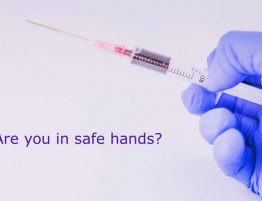
Whenever I start to write a blog post, I ask myself, who is the receiver and what is the purpose? This blog post is one of the very important ones, and of course answering the above questions was not difficult. I write it mainly to you, who use gloves in your daily work. Also to you who sell gloves, enabling you to guide your customers better. And why do I write it? Because if you are so unfortunate to get an allergy from anything you work with, it can change your life. You could be forced to change the carrier you love. Therefore – “awareness” – is the main purpose of this blog post.
I would like to start with a story about a flower arranger I met many years ago.
I was going to buy a bouquet of flowers, and he was arranging it in a very nice way.
He had some problems doing it, because he was wearing big cotton gloves, and he complained a little bit about it. I asked him, why he had to wear those gloves, and he told me that he was very allergic to something from the flowers, and therefore he could not get in direct contact with the flowers.
The cotton gloves did not really help, and he told me that he actually had to close down his own flower shop due to this allergy. He was only helping out in this shop once in a while, because he really loved working with flowers.
I asked him, whether he had ever tried to use disposable gloves. He said that he had tried latex gloves, but it did not help him.
A couple of days later I passed by the shop. He was not there. I left a box of nitrile gloves for him.
Later I learned that he had started a flower shop again, and he was using nitrile gloves every day. With this solution, he could keep doing what he loved doing – without any problems with his hands.
This story is of course not about an allergy from gloves, but it proves a point. You might be forced to change your carrier, if you suffer from an allergy.
If you use gloves often and long time during your work, you might encounter a risk of getting an allergy.
There are 2 different types of allergy you can get when using gloves – Type I and Type IV
Type I is a hypersensitivity which is provoked by re-exposure to an allergen. In the case of gloves this allergen is latex proteins. This allergy is therefore only from using latex gloves.
Typically, this type of allergy will start on your hands – where you wear the glove, and later it develops to more flue like symptoms. In worst cases, it can lead to anaphylactic shock. It is the most severe of the 2 types. Often a person with latex allergy also have some food allergy like towards kiwi, banana etc.
Type IV is a delayed type hypersensitivity against accelerators (also called rubber chemicals) used in the gloves. Delayed because it takes 2-3 days to develop. This allergy will only be on your hands where you wear the gloves.
Accelerators are used in latex gloves and most synthetic gloves.
Most people reacting to gloves, believe that they have a latex allergy, but often it is not a latex allergy, but it is reaction to the accelerators used in the gloves.
What should you do if you are so unfortunate to react to your gloves?
It is important for you to get clearance about the exact cause of the allergy. There are several reasons for that. When you know what, you react to, it is;
- easier for you to avoid it.
- possible for you to find another glove that you can use
- it is “easier” for you to live with the allergy the rest of your life, because the sooner you avoid the allergen, the better.
Sometimes you will also experience that it is not the glove itself you react to, but it could be other things in your environment, like a new soap, cream or others.
What can you do to minimize the risk?
- Use the glove as long as necessary, but as short as possible
- If you use gloves for a longer time, always wear a cotton glove under your glove, it can help absorb the sweat from your hands, and avoid that the pores on your hands open too much.
- Take good care of your hands also after work
- Use a good hand cream
- If you get a reaction on your hand avoid further exposure, and find out what you need to avoid in the future
What should you be aware of as a buyer of gloves?
You should know which chemicals are used in the production. Your customers are entitled to be informed, what the gloves might contain.The washing process during production is also important to know. The more efficient the washing process is the fewer residual chemicals. This leads to a lower risk of allergies.
Protein value (in latex gloves).
Latex proteins are the triggers a latex allergy (Type I), therefore the protein level should be as low as possible. The protein level in a powdered glove is much higher than in a powder free glove, which is one of the reasons, you should always use powder free gloves.
There is no safe level, but below 50 µg/g is a good indication to minimize the risk of building an allergy.
Before we market gloves we need to make a pre-clinical evaluation. Part of this evaluation is a sensitization and irritation test. This is to make sure that the glove you use, has a low risk of giving you an allergy
EN 455-3 requires that this is made for any type of medical single use glove.
What would you do, if you got an allergy?
I hope the blog has given you some insight into the allergy issue. If you have an allergy, it is important that you find out exactly what you are allergic to. Then it is easier to find, whether there is a glove, that you can substitute your current with.
Remember always to take good care of your hands – also when you are not working.
If you have any questions, and if you are not sure what you should look for, when you buy gloves, e-mail me: rikke@glove-insite.com



